Discrepancies in Mapping Sustainable Development Goal 3 (Good Health and Well-Being) Research: A Comparative Analysis of Scopus and Dimensions Databases
Abstract
:1. Introduction
- RQ1: How does the trend of SDG 3 mapped publications compare in Scopus and Dimensions?
- RQ2: What is the pattern of disparities in SDG 3 mapped publications when studied at country, funder, institution, journal, and author level?
- RQ3: Is there a significant difference between citation counts of the same paper between Scopus and Dimensions?
- RQ4: Are there temporal trends in citation differences between Scopus and Dimensions?
2. Literature Review
3. Methodology
Search Strategy
4. Results and Discussion
4.1. Publication Trends
4.2. Prolific Countries
4.3. Top Funders
4.4. Productive Institutions
4.5. Top Journals
4.6. Influential Authors
4.7. Keyword Co-Occurrence Analysis
4.8. Citation Trends
5. Conclusions
Author Contributions
Funding
Institutional Review Board Statement
Informed Consent Statement
Data Availability Statement
Conflicts of Interest
References
- Sachs, J.D. From millennium development goals to sustainable development goals. Lancet 2012, 379, 2206–2211. [Google Scholar] [CrossRef] [PubMed]
- UN. Transforming Our World: The 2030 Agenda for Sustainable Development; Resolution Adopted by the General Assembly on 25 September 2015; UN: New York, NY, USA, 2015.
- de Jong, E.; Vijge, M.J. From Millennium to Sustainable Development Goals: Evolving discourses and their reflection in policy coherence for development. Earth Syst. Gov. 2021, 7, 100087. [Google Scholar] [CrossRef]
- Fonseca, L.; Carvalho, F. The reporting of SDGs by quality, environmental, and occupational health and safety-certified organizations. Sustainability 2019, 11, 5797. [Google Scholar] [CrossRef]
- Schmalzbauer, B.S. (Ed.) The Contribution of Science in Implementing the Sustainable Development Goals; German Committee Future Earth: Hamburg, Germany, 2016. [Google Scholar]
- Raman, R.; Nair, V.K.; Shivdas, A.; Bhukya, R.; Viswanathan, P.K.; Subramaniam, N.; Nedungadi, P. Mapping sustainability reporting research with the UN’s sustainable development goal. Heliyon 2023, 9, e18510. [Google Scholar] [CrossRef] [PubMed]
- Sreenivasan, A.; Ma, S.; Nedungadi, P.; Sreedharan, V.R.; Raman, R.R. Interpretive Structural Modeling: Research Trends, Linkages to Sustainable Development Goals, and Impact of COVID-19. Sustainability 2023, 15, 4195. [Google Scholar] [CrossRef]
- Armitage, C.S.; Lorenz, M.; Mikki, S. Mapping scholarly publications related to the Sustainable Development Goals: Do independent bibliometric approaches get the same results? Quant. Sci. Stud. 2020, 1, 1092–1108. [Google Scholar] [CrossRef]
- Balsiger, J.; Förster, R.; Mader, C.; Nagel, U.; Sironi, H.; Wilhelm, S.; Zimmermann, A.B. Transformative learning and education for sustainable development. GAIA-Ecol. Perspect. Sci. Soc. 2017, 26, 357–359. [Google Scholar] [CrossRef]
- Moher, D.; Shamseer, L.; Clarke, M.; Ghersi, D.; Liberati, A.; Petticrew, M.; Shekelle, P.; Stewart, L.A.; PRISMA-P Group. Preferred reporting items for systematic review and meta-analysis protocols (prisma-p) 2015 statement. Syst. Rev. 2015, 4, 1. [Google Scholar] [CrossRef]
- Github. (n.d.). Aurora-Network-Global’s SDG-Queries. Available online: https://github.com/Aurora-Network-Global/sdg-queries (accessed on 13 July 2023).
- Auckland’s SDG Mapping (n.d). University of Auckland’s SDG Mapping Initiative. Available online: https://www.sdgmapping.auckland.ac.nz/ (accessed on 13 July 2023).
- Mohammed, A.J.; Ghebreyesus, T.A. Healthy living, well-being and the sustainable development goals. Bull. World Health Organ. 2018, 96, 590. [Google Scholar] [CrossRef]
- Filho, W.L.; Brandli, L.L.; Salvia, A.L.; Rayman-Bacchus, L.; Platje, J. COVID-19 and the UN sustainable development goals: Threat to solidarity or an opportunity? Sustainability 2020, 12, 5343. [Google Scholar] [CrossRef]
- Bhatia, R.; Khetrapal, S. Impact of COVID-19 pandemic on health system & sustainable development goal 3. Indian J. Med. Res. 2020, 151, 395–399. [Google Scholar] [CrossRef]
- Ali, S.M.; Appolloni, A.; Cavallaro, F.; D’adamo, I.; Di Vaio, A.; Ferella, F.; Gastaldi, M.; Ikram, M.; Kumar, N.M.; Martin, M.A.; et al. Development Goals towards Sustainability. Sustainability 2023, 15, 9443. [Google Scholar] [CrossRef]
- Blasco, N.; Brusca, I.; Labrador, M. Drivers for universities’ contribution to the sustainable development goals: An analysis of spanish public universities. Sustainability 2020, 13, 89. [Google Scholar] [CrossRef]
- Roberge, G.; Kashnitsky, Y.; James, C. Elsevier 2022 Sustainable Development Goals (SDG) Mapping. Mendeley Data 2022, 1, 2022. [Google Scholar]
- Olawumi, T.O.; Chan, D.W. A scientometric review of global research on sustainability and sustainable development. J. Clean. Prod. 2018, 183, 231–250. [Google Scholar] [CrossRef]
- Meschede, C. The sustainable development goals in scientific literature: A bibliometric overview at the meta-level. Sustainability 2020, 12, 4461. [Google Scholar] [CrossRef]
- Tilbury, D. Higher education for sustainability: A global overview of commitment and progress. High. Educ. World 2011, 4, 18–28. [Google Scholar]
- Körfgen, A.; Förster, K.; Glatz, I.; Maier, S.; Becsi, B.; Meyer, A.; Kromp-Kolb, H.; Stötter, J. It’s a hit! Mapping austrian research contributions to the sustainable development goals. Sustainability 2018, 10, 3295. [Google Scholar] [CrossRef]
- Thelwall, M. Dimensions: A competitor to Scopus and the Web of Science? J. Inf. 2018, 12, 430–435. [Google Scholar] [CrossRef]
- Harzing, A.-W. Two new kids on the block: How do Crossref and Dimensions compare with Google Scholar, Microsoft Academic, Scopus and the Web of Science? Scientometrics 2019, 120, 341–349. [Google Scholar] [CrossRef]
- Kar, S.K.; Harichandan, S. Green marketing innovation and sustainable consumption: A bibliometric analysis. J. Clean. Prod. 2022, 361, 132290. [Google Scholar] [CrossRef]
- Chistov, V.; Aramburu, N.; Carrillo-Hermosilla, J. Open eco-innovation: A bibliometric review of emerging research. J. Clean. Prod. 2021, 311, 127627. [Google Scholar] [CrossRef]
- Harichandan, S.; Kar, S.K.; Bansal, R.; Mishra, S.K.; Balathanigaimani, M.S.; Dash, M. Energy transition research: A bibliometric mapping of current findings and direction for future research. Clean. Prod. Lett. 2022, 3, 100026. [Google Scholar] [CrossRef]
- Visser, M.; van Eck, N.J.; Waltman, L. Large-scale comparison of bibliographic data sources: Scopus, Web of Science, Dimensions, Crossref, and Microsoft Academic. Quant. Sci. Stud. 2021, 2, 20–41. [Google Scholar] [CrossRef]
- Mongeon, P.; Paul-Hus, A. The journal coverage of Web of Science and Scopus: A comparative analysis. Scientometrics 2016, 106, 213–228. [Google Scholar] [CrossRef]
- Gavel, Y.; Iselid, L. Web of Science and Scopus: A journal title overlap study. Online Inf. Rev. 2008, 32, 8–21. [Google Scholar] [CrossRef]
- Jayabalasingham, B.; Boverhof, R.; Agnew, K.; Klein, L. Identifying research supporting the United Nations Sustainable Development Goals. Mendeley Data 2019, 1. [Google Scholar] [CrossRef]
- Raman, R.; Subramaniam, N.; Nair, V.K.; Shivdas, A.; Achuthan, K.; Nedungadi, P. Women entrepreneurship and sustainable development: Bibliometric analysis and emerging research trends. Sustainability 2022, 14, 9160. [Google Scholar] [CrossRef]
- Achuthan, K.; Nair, V.K.; Kowalski, R.; Ramanathan, S.; Raman, R. Cyberbullying research—Alignment to sustainable development and impact of COVID-19: Bibliometrics and science mapping analysis. Comput. Hum. Behav. 2023, 140, 107566. [Google Scholar] [CrossRef]
- Fonseca, L.M.; Domingues, J.P.; Dima, A.M. Mapping the sustainable development goals relationships. Sustainability 2020, 12, 3359. [Google Scholar] [CrossRef]
- Dibbern, T.A.; Rampasso, I.S.; Serafim, M.P.; Bertazzoli, R.; Filho, W.L.; Anholon, R. Bibliometric study on SDG 6: Analysing main content aspects by using Web of Science data from 2015 to 2021. Kybernetes 2022. [Google Scholar] [CrossRef]
- Steingard, D.; Balduccini, M.; Sinha, A. Applying AI for social good: Aligning academic journal ratings with the United Nations Sustainable Development Goals (SDGs). AI Soc. 2023, 38, 613–629. [Google Scholar] [CrossRef]
- Bautista-Puig, N.; Orduña-Malea, E.; Perez-Esparrells, C. Enhancing sustainable development goals or promoting universities? An analysis of the times higher education impact rankings. Int. J. Sustain. High. Educ. 2022, 23, 211–231. [Google Scholar] [CrossRef]
- Wang, R.-J.; Shih, Y.-H. What are universities pursuing? A review of the Quacquarelli Symonds world university rankings of Taiwanese universities (2021–2023). Front. Educ. 2023, 8, 1185817. [Google Scholar] [CrossRef]
- Park, J.; Savelyeva, T. An interpretive analysis of the 2030 sustainable development goals in Hong Kong public universities. Asia Pac. Educ. Rev. 2022, 23, 543–558. [Google Scholar] [CrossRef]
- Raman, R.; Vinuesa, R.; Nedungadi, P. Bibliometric analysis of SARS, MERS, and COVID-19 studies from India and connection to sustainable development goals. Sustainability 2021, 13, 7555. [Google Scholar] [CrossRef]
- Raji, S.A.; Demehin, M.O. “Long walk to 2030”: A bibliometric and systematic review of research trends on the UN sustainable development goal 3. Dialogues Health 2023, 2, 100132. [Google Scholar] [CrossRef]
- Schmidt, F.; Vanderfeesten, M. Evaluation on accuracy of mapping science to the United Nations’ Sustainable Development Goals (SDGs) of the Aurora SDG queries. Zenodo 2021. [Google Scholar] [CrossRef]
- Nishikawa-Pacher, A. Who are the 100 largest scientific publishers by journal count? A webscraping approach. J. Doc. 2022, 78, 450–463. [Google Scholar] [CrossRef]
- Siler, K.; Vincent-Lamarre, P.; Sugimoto, C.R.; Larivière, V. Predatory publishers’ latest scam: Bootlegged and rebranded papers. Nature 2021, 598, 563–565. [Google Scholar] [CrossRef]
- Van Eck, N.J.; Waltman, L. Visualizing bibliometric networks. In Measuring Scholarly Impact: Methods and Practice; Springer International Publishing: Cham, Switzerland, 2014; pp. 285–320. [Google Scholar] [CrossRef]
- Radhakrishnan, S.; Erbis, S.; Isaacs, J.A.; Kamarthi, S. Novel keyword co-occurrence network-based methods to foster systematic reviews of scientific literature. PLoS ONE 2017, 12, e0185771. [Google Scholar] [CrossRef]
- Pakkan, S.; Sudhakar, C.; Tripathi, S.; Rao, M. A correlation study of sustainable development goal (SDG) interactions. Qual. Quant. 2023, 57, 1937–1956. [Google Scholar] [CrossRef] [PubMed]
- Wastl, J. 6.2 Expanding Dimensions: A New Source in the Bibliometrician’s Toolbox. In Handbook Bibliometrics; Walter de Gruyter GmbH & Co KG: Berlin, Germany, 2020; Volume 421. [Google Scholar]
- Sweileh, W.M. Bibliometric analysis of scientific publications on “sustainable development goals” with emphasis on “good health and well-being” goal (2015–2019). Glob. Health 2020, 16, 68. [Google Scholar] [CrossRef] [PubMed]

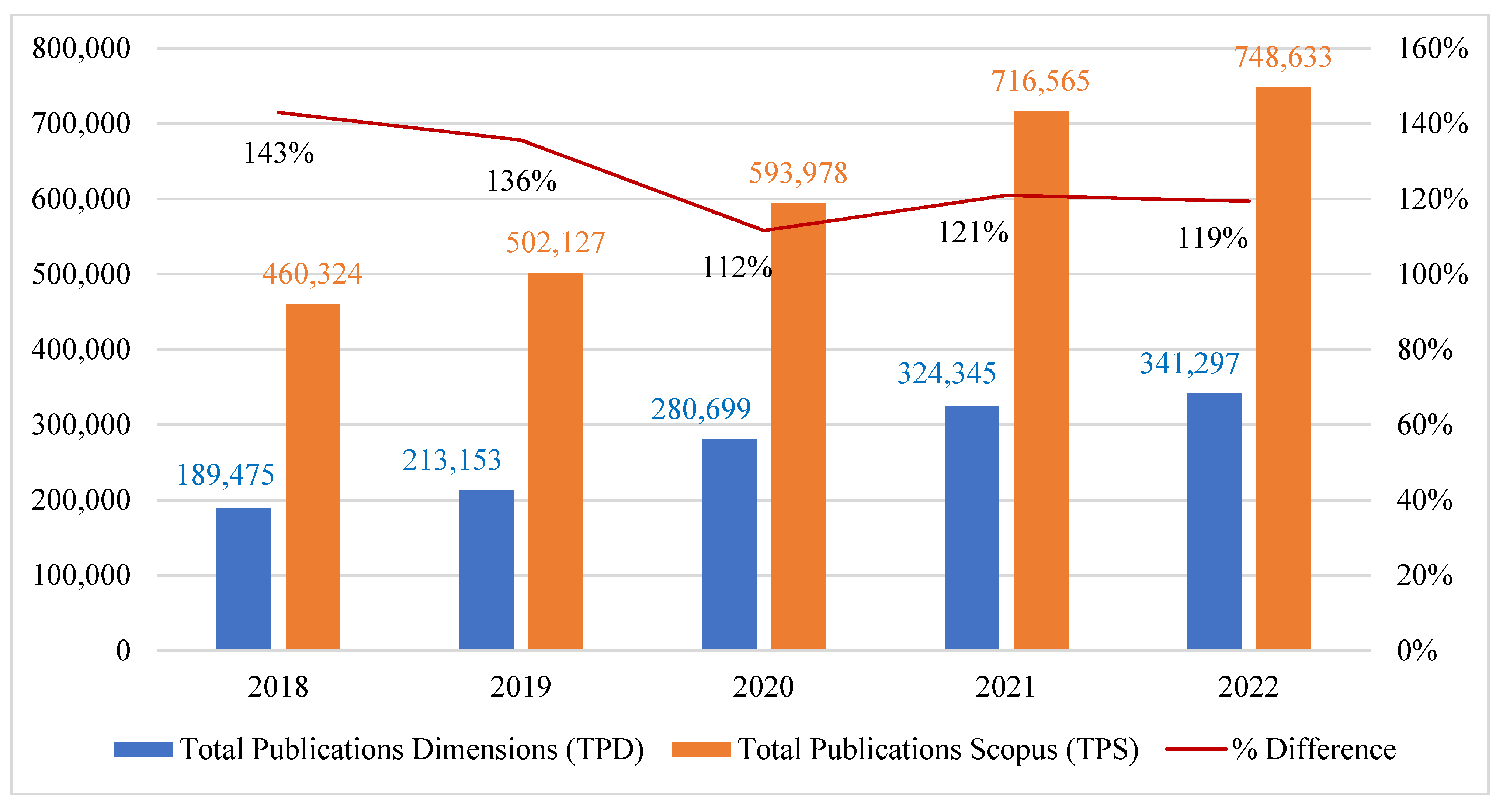
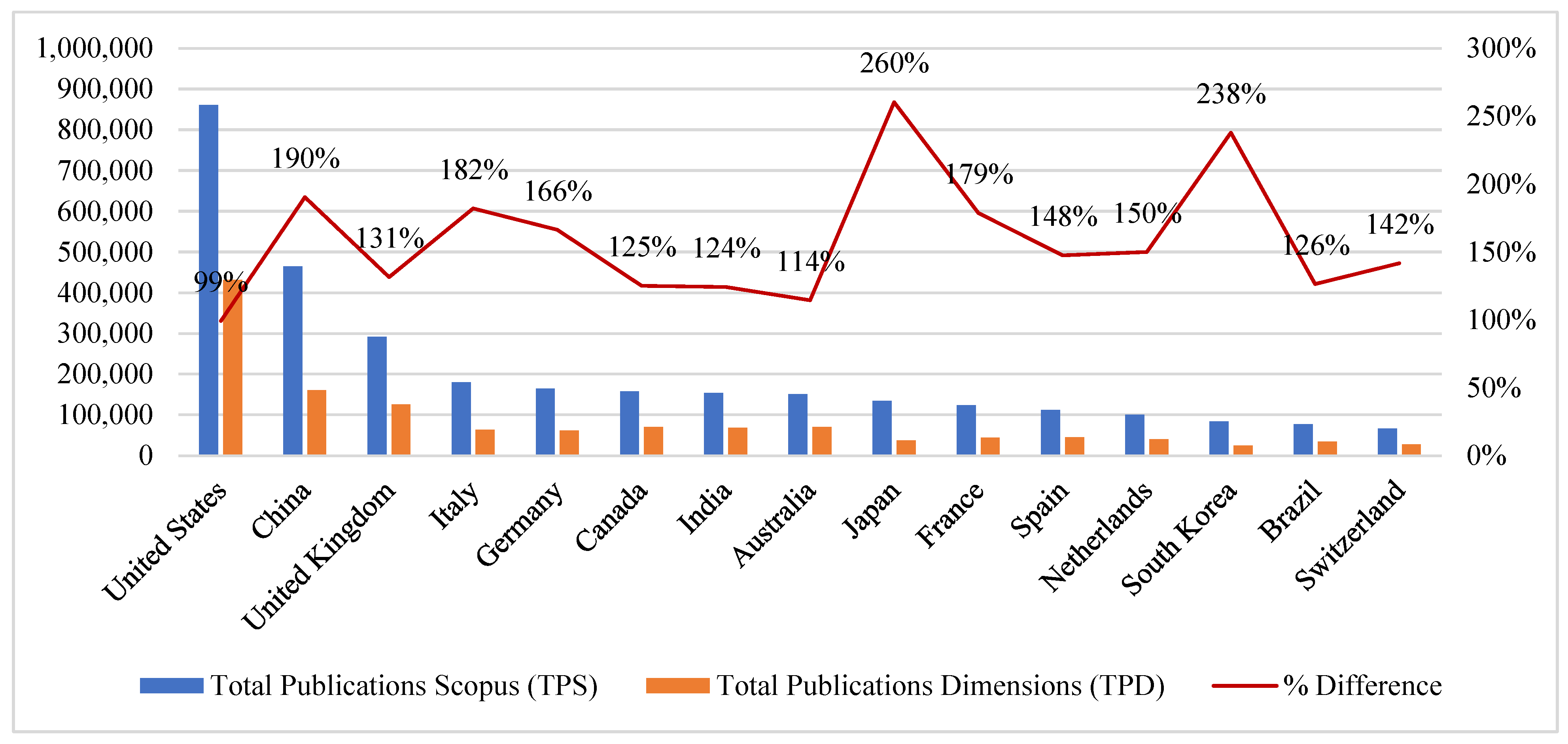
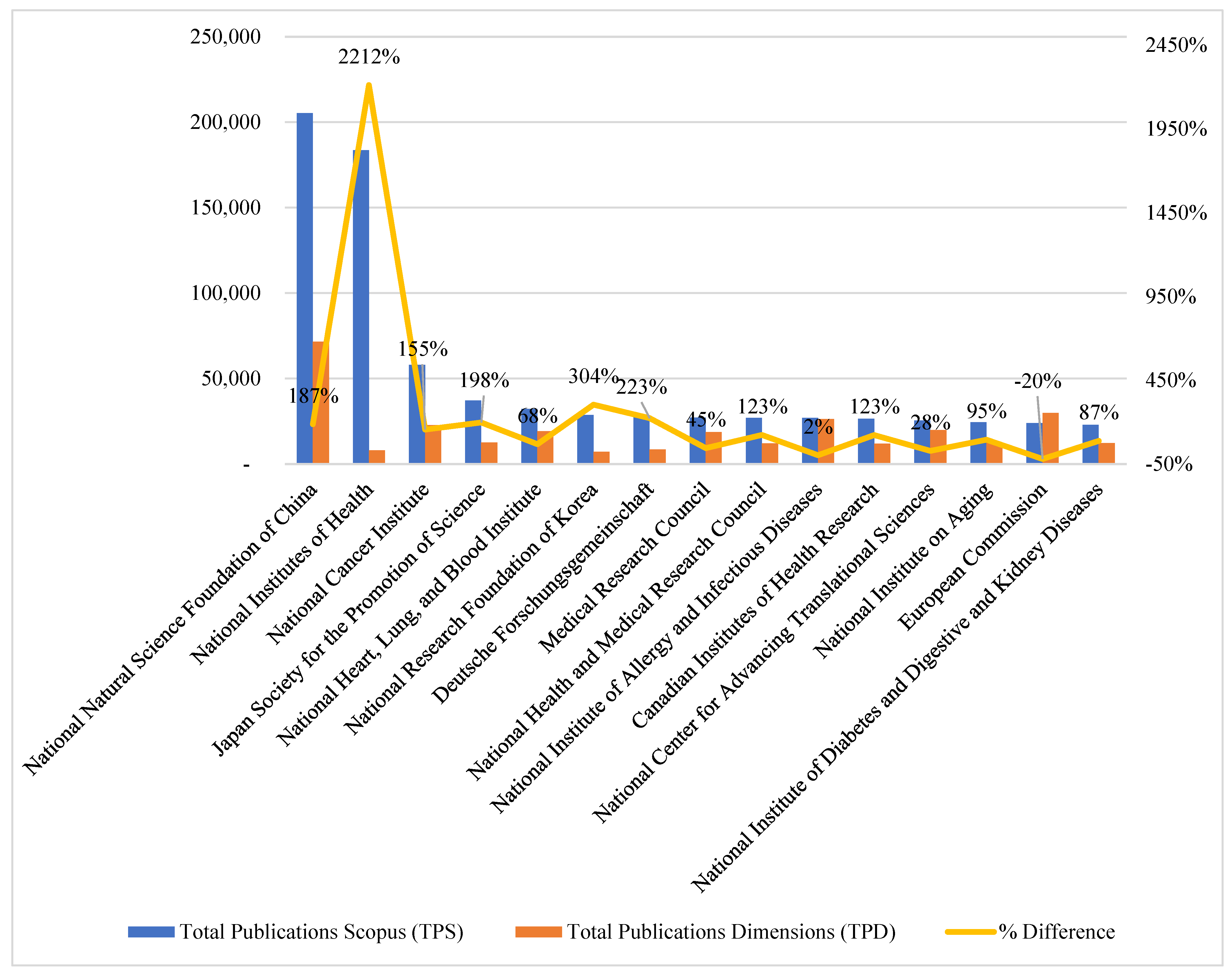
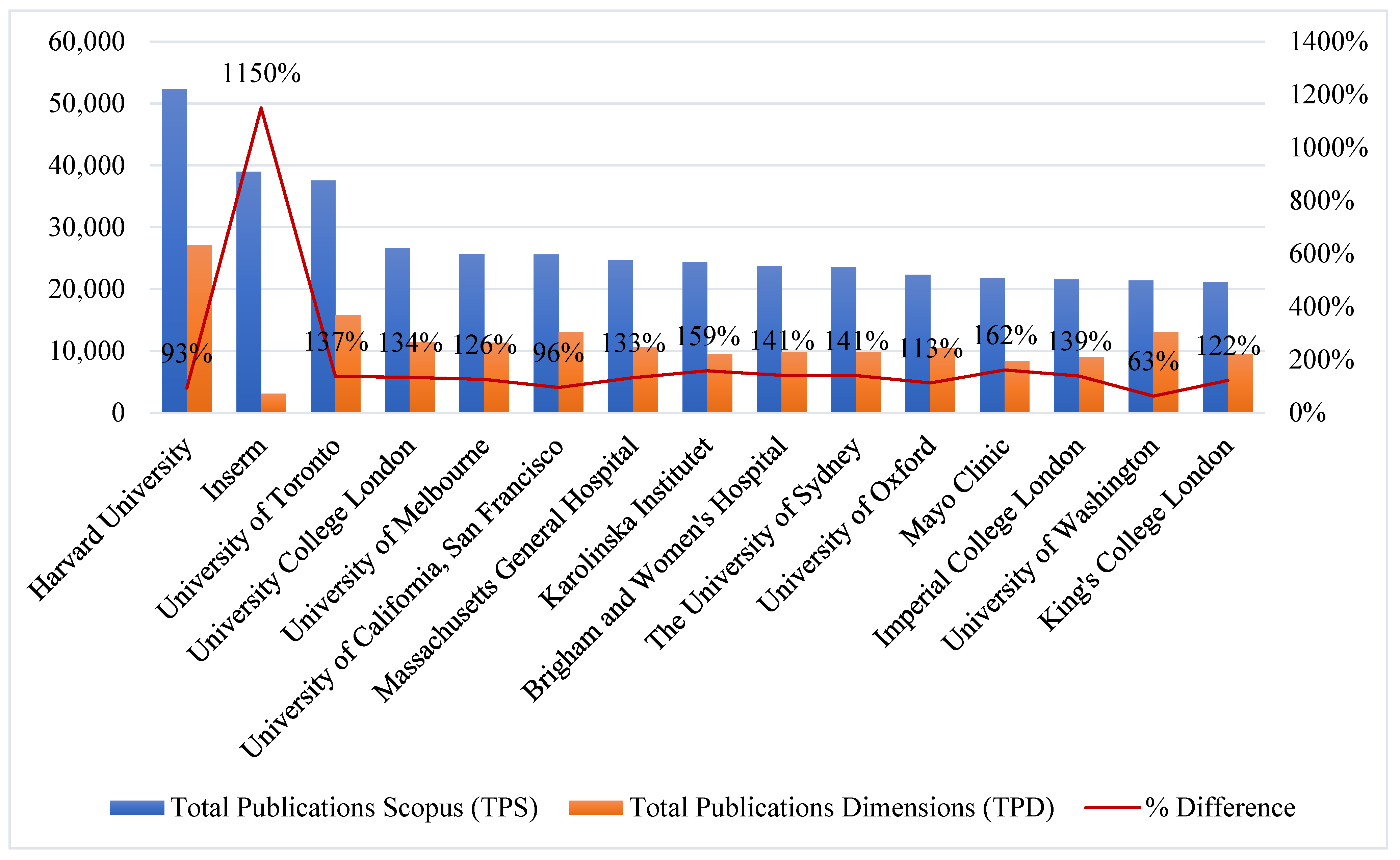

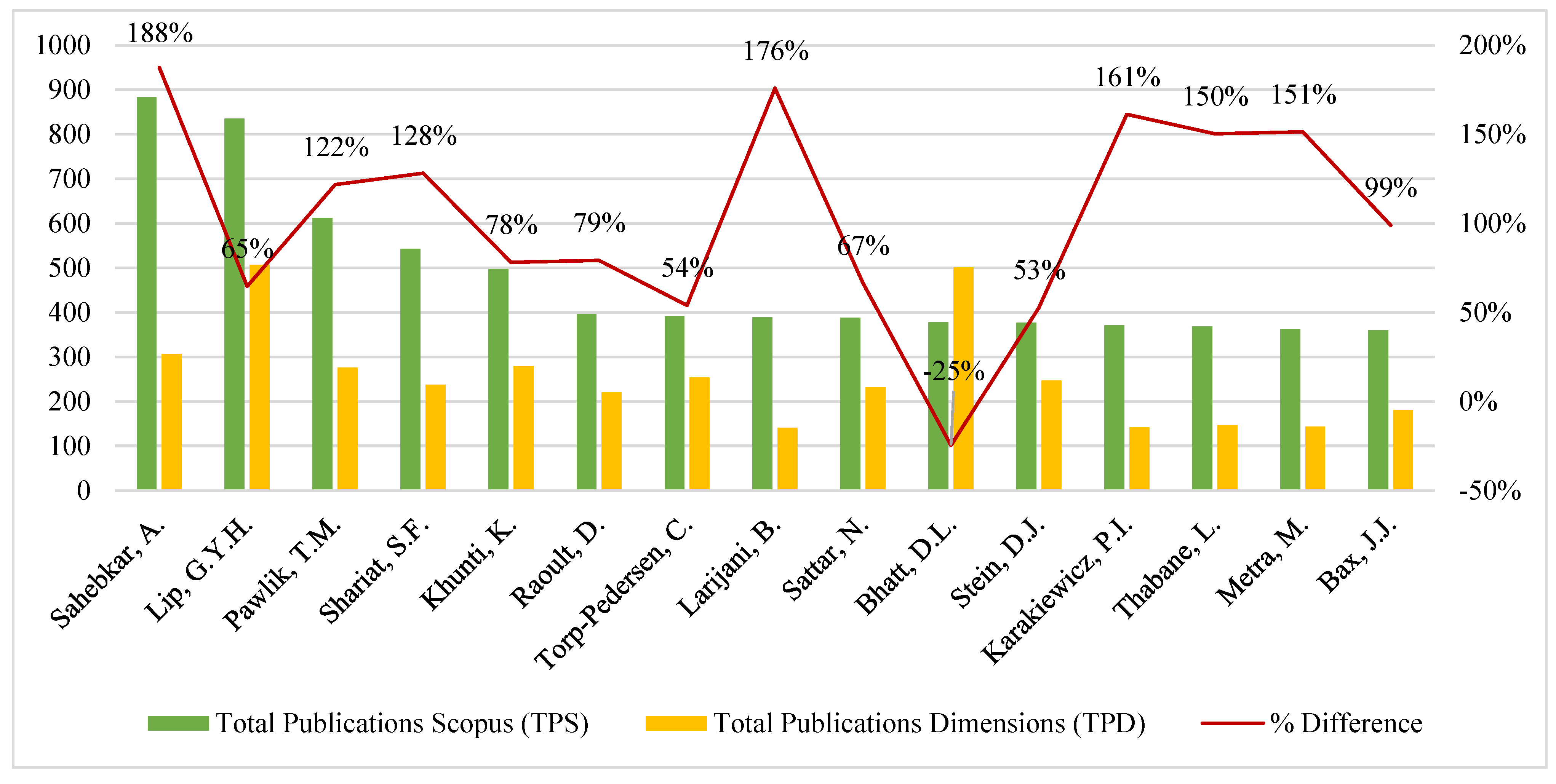
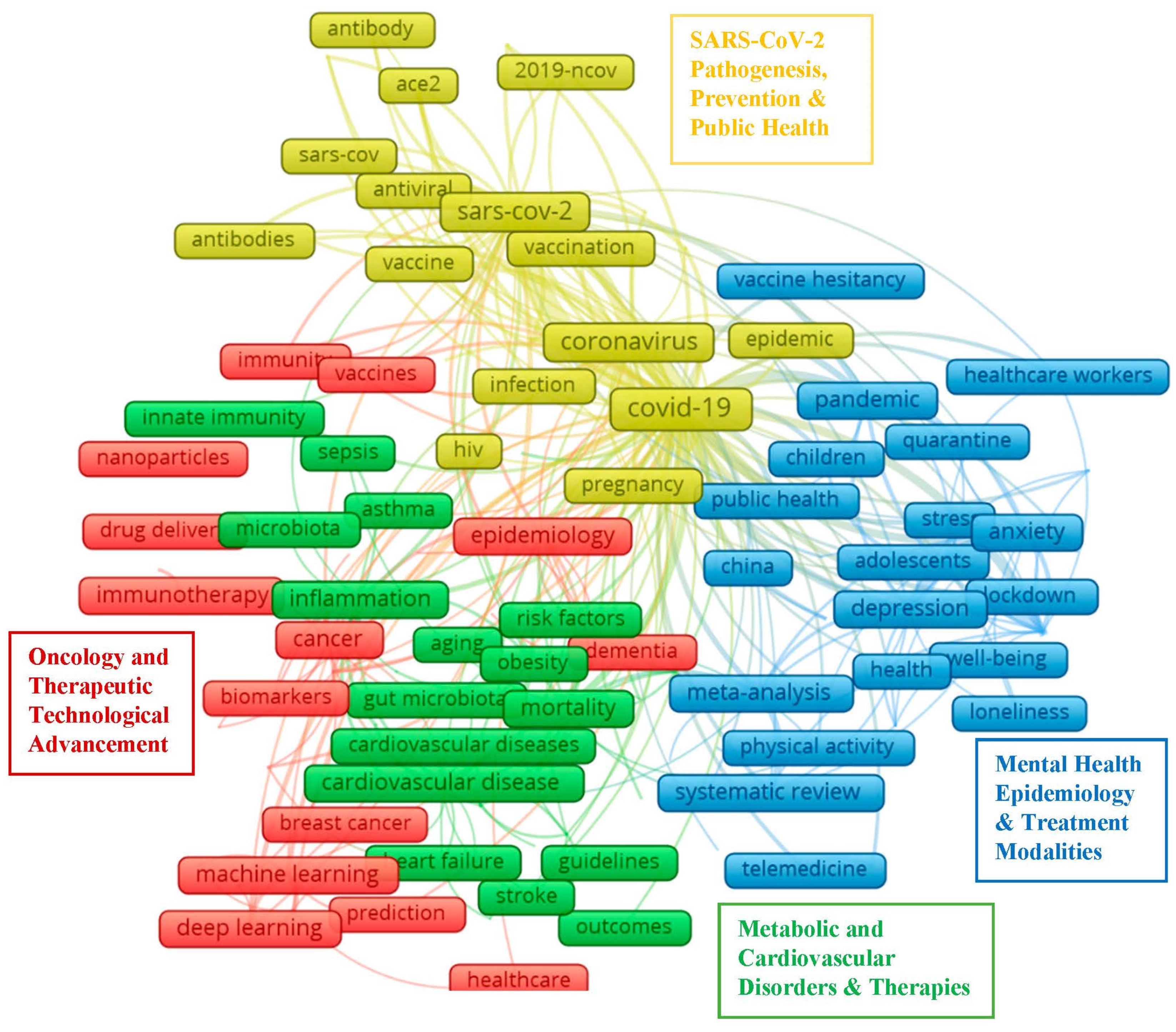
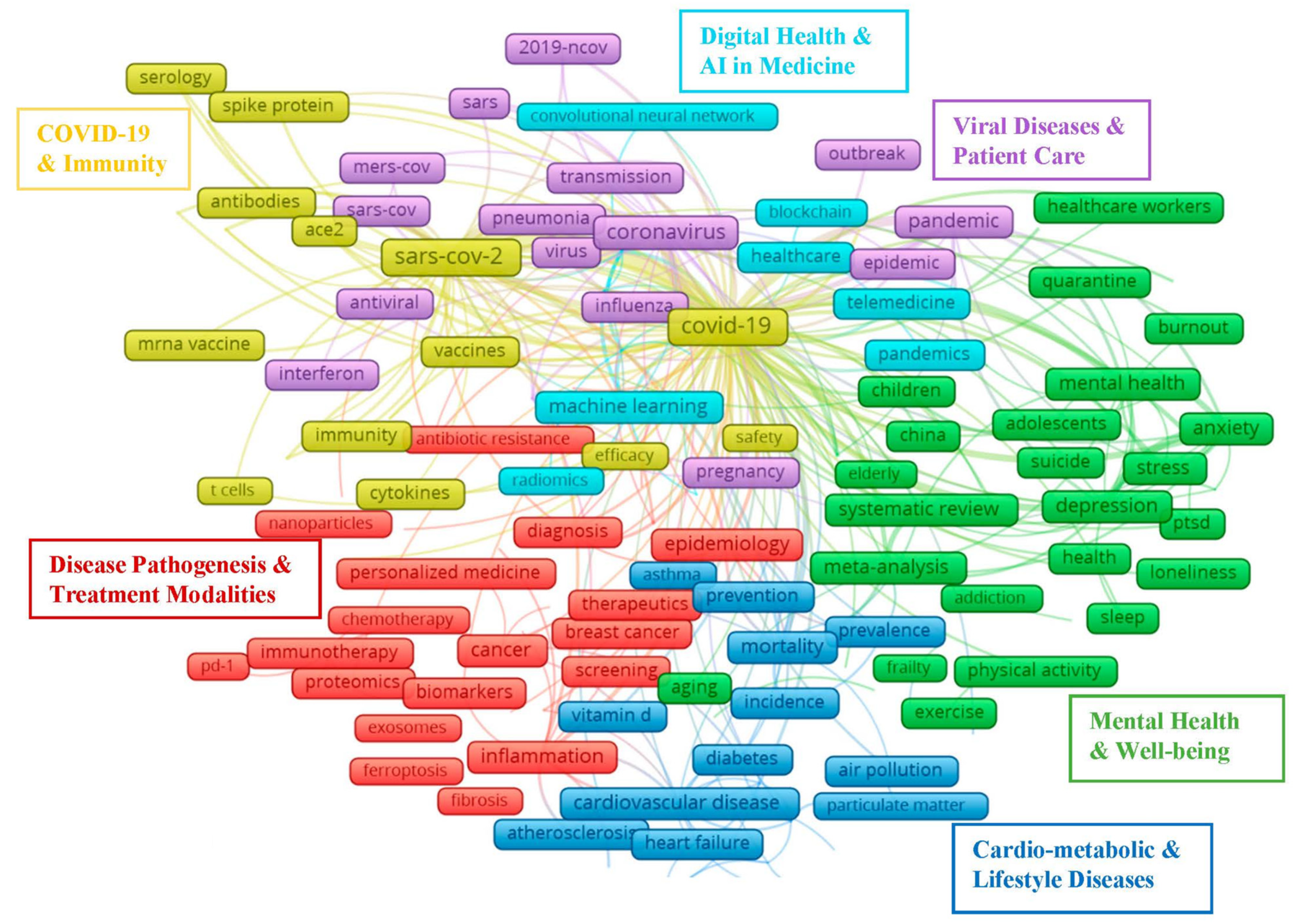
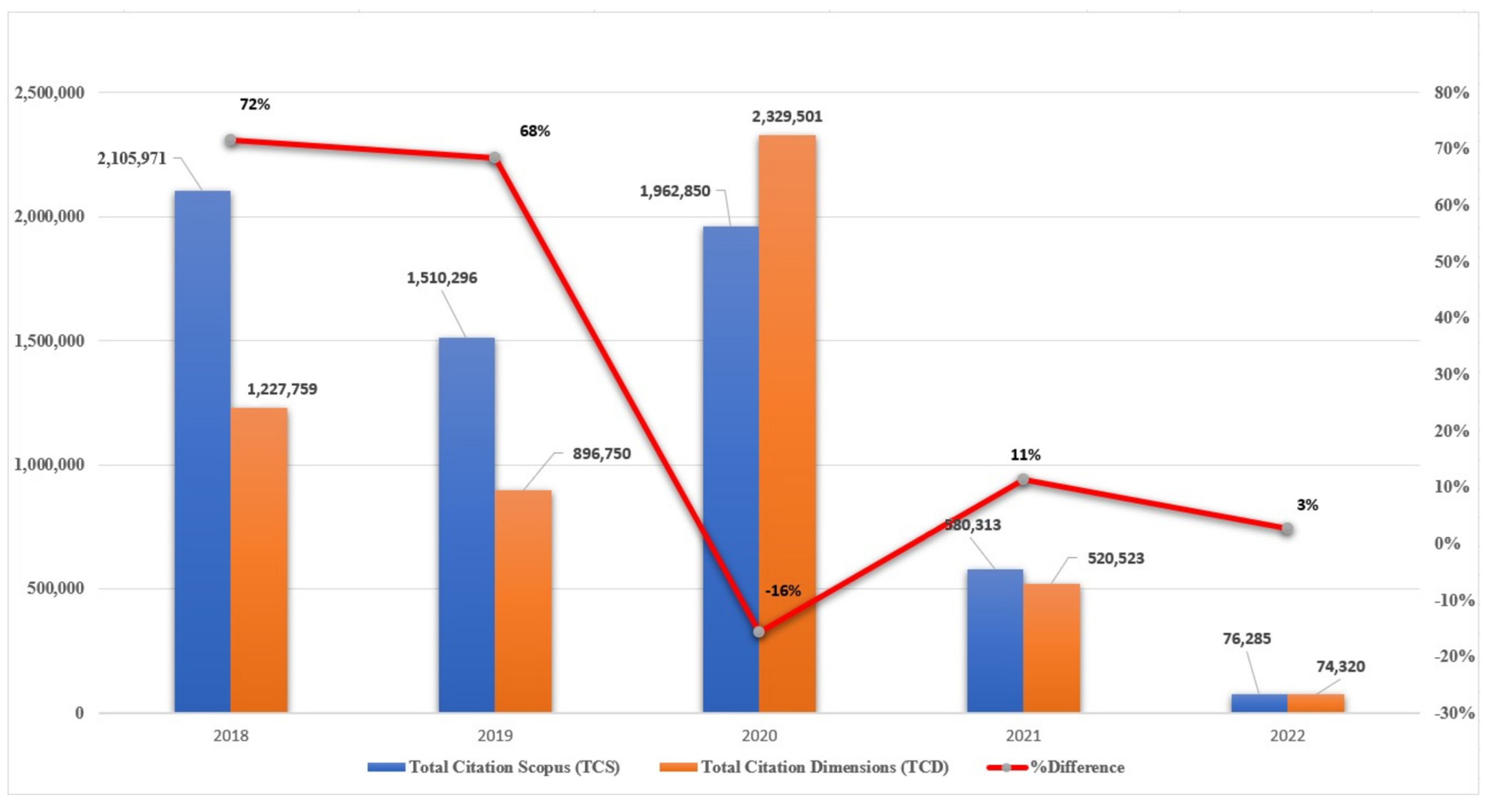
| No. | Publisher Name |
|---|---|
| 1 | American Chemical Society |
| 2 | British Medical Journal |
| 3 | Bio Med Central |
| 4 | Cambridge University Press |
| 5 | De Gruyter |
| 6 | Elsevier |
| 7 | Emerald |
| 8 | Frontiers |
| 9 | Hindawi |
| 10 | IGI Global |
| 11 | IOP Publishing |
| 12 | Inderscience Publishers |
| 13 | Institute of Electrical and Electronics Engineers |
| 14 | MDPI |
| 15 | OMICS International |
| 16 | Oxford University Press |
| 17 | Public Library of Science |
| 18 | SAGE Publications |
| 19 | Science Publishing Group |
| 20 | Springer Nature |
| 21 | Taylor & Francis |
| 22 | Wiley |
| 23 | Wolters Kluwer |
| Search Query—Scopus (n = 3,021,627) |
| TITLE-ABS-KEY (((human AND (health* OR disease* OR illness* OR medicine* OR mortality)) OR {battered child syndrome} OR {cardiovascular disease} OR {cardiovascular diseases} OR {chagas} OR {child abuse} OR {child neglect} OR {child well-being index} OR {youth well-being index} OR {child wellbeing index} OR {youth wellbeing index} OR {water-borne disease} OR {water-borne diseases} OR {water borne disease} OR {water borne diseases} OR {tropical disease} OR {tropical diseases} OR {chronic respiratory disease} OR {chronic respiratory diseases} OR {infectious disease} OR {infectious diseases} OR {sexually-transmitted disease} OR {sexually transmitted disease} OR {sexually-transmitted diseases} OR {sexually transmitted diseases} OR {communicable disease} OR {communicable diseases} OR aids OR hiv OR {human immunodeficiency virus} OR tuberculosis OR malaria OR hepatitis OR polio* OR vaccin* OR cancer* OR diabet* OR {maternal mortality} OR {child mortality} OR {childbirth complications} OR {neonatal mortality} OR {neo-natal mortality} OR {premature mortality} OR {infant mortality} OR {quality adjusted life year} OR {maternal health} OR {preventable death} OR {preventable deaths} OR {tobacco control} OR {substance abuse} OR {drug abuse} OR {tobacco use} OR {alcohol use} OR {substance addiction} OR {drug addiction} OR {tobacco addiction} OR alcoholism OR suicid* OR {postnatal depression} OR {post-natal depression} OR {zika virus} OR dengue OR schistosomiasis OR {sleeping sickness} OR ebola OR {mental health} OR {mental disorder} OR {mental illness} OR {mental illnesses} OR {measles} OR {neglected disease} OR {neglected diseases} OR diarrhea OR diarrhoea OR cholera OR dysentery OR {typhoid fever} OR {traffic accident} OR {traffic accidents} OR {healthy lifestyle} OR {life expectancy} OR {life expectancies} OR {health policy} OR ({health system} AND (access OR accessible)) OR {health risk} OR {health risks} OR {inclusive health} OR obesity OR {social determinants of health} OR {psychological harm} OR {psychological wellbeing} OR {psychological well-being} OR {psychological well-being} OR {public health})) and (publisher(american chemical*) OR publisher(biomed*) OR (bmj*) OR (british medical*) OR publisher(cambridge*) OR publisher(*gruyter*) OR publisher(elsevi*) OR publisher(emerald*) OR publisher(frontier*) OR publisher(hindawi*) OR publisher(igi global*) OR publisher(iop*) OR publisher(inderscience*) OR publisher(Institute of Electrical and Electronics Engineers) OR publisher(ieee*) OR publisher(MDPI*) OR (multi-disciplinary*) OR publisher(nature*) OR publisher(omics*) OR publisher(oxford university*) OR publisher(public library*) OR publisher(routledge*) OR publisher(sage*) OR publisher(science publishing group*) OR publisher(Springer*) OR publisher(nature*) OR publisher(taylor*) OR publisher(wiley*) OR publisher(*wolters*)) AND (LIMIT-TO (DOCTYPE, ”ar”) OR LIMIT-TO (DOCTYPE, ”ch”) OR LIMIT-TO (DOCTYPE, ”re”) OR LIMIT-TO (DOCTYPE, ”cp”) OR LIMIT-TO (DOCTYPE, ”bk”) OR LIMIT-TO (DOCTYPE, ”no”) OR LIMIT-TO (DOCTYPE, ”ed”) OR LIMIT-TO (DOCTYPE, ”le”) OR LIMIT-TO (DOCTYPE, ”dp”) OR LIMIT-TO (DOCTYPE, ”sh”)) AND (LIMIT-TO (PUBYEAR,2022) OR LIMIT-TO (PUBYEAR,2021) OR LIMIT-TO (PUBYEAR,2020) OR LIMIT-TO (PUBYEAR,2019) OR LIMIT-TO (PUBYEAR,2018)) AND (LIMIT-TO (LANGUAGE, ”English”)) |
| Search Query—Dimensions (n = 1,348,969) |
| https://app.dimensions.ai/discover/publication?search_mode=content&search_text=language%3Aen&search_type=kws&search_field=full_search&order=times_cited&or_facet_year=2022&or_facet_year=2021&or_facet_year=2020&or_facet_year=2019&or_facet_year=2018&or_facet_user_group_facet=f5d5ce00-20ab-42df-9e87-29a09b90853e&or_facet_publication_type=article&or_facet_publication_type=chapter&or_facet_publication_type=proceeding&or_facet_publication_type=book&or_facet_sdg=40003 (accessed on 13 July 2023) IF (((STARTSWITH([Code ASJC], ”27”) OR STARTSWITH([Code ASJC], ”29”) OR STARTSWITH([Code ASJC], ”35”) OR STARTSWITH([Code ASJC], ”36”) OR STARTSWITH([Code ASJC], ”24”) OR STARTSWITH([Code ASJC], ”28”) OR STARTSWITH([Code ASJC], ”30”) OR STARTSWITH([Code ASJC], ”32”) OR [Code ASJC]=“3306”) OR (STARTSWITH([Code ASJC], ”32”) AND (CONTAINS([TI-ABS-KW], “hospital”) OR CONTAINS([TI-ABS-KW], “medical staff”) OR CONTAINS([TI-ABS-KW], “doctor”) OR CONTAINS([TI-ABS-KW], “nurse”) OR CONTAINS([TI-ABS-KW], “physician”) OR CONTAINS([TI-ABS-KW], “health”))) OR (CONTAINS([TI-ABS-KW], “good health and well-being”) OR (CONTAINS([TI-ABS-KW], “human”) AND (CONTAINS([TI-ABS-KW], ”health”) OR CONTAINS([TI-ABS-KW], “disease”) OR CONTAINS([TI-ABS-KW], “illness”) OR CONTAINS([TI-ABS-KW], “medicine”) OR CONTAINS([TI-ABS-KW], “mortality”))) OR CONTAINS([TI-ABS-KW], “battered child syndrome”) OR CONTAINS([TI-ABS-KW], “cardiovascular disease”) OR CONTAINS([TI-ABS-KW], “cardiovascular diseases”) OR CONTAINS([TI-ABS-KW], “chagas”) OR CONTAINS([TI-ABS-KW], “child abuse”) OR CONTAINS([TI-ABS-KW], “child neglect”) OR CONTAINS([TI-ABS-KW], “human wellbeing”) OR CONTAINS([TI-ABS-KW], “human well-being”) OR CONTAINS([TI-ABS-KW], “youth wellbeing”) OR CONTAINS([TI-ABS-KW], “youth well-being”) OR CONTAINS([TI-ABS-KW], “child wellbeing”) OR CONTAINS([TI-ABS-KW], “child well-being”) OR CONTAINS([TI-ABS-KW], “woman wellbeing”) OR CONTAINS([TI-ABS-KW], “woman well-being”) OR CONTAINS([TI-ABS-KW], “women wellbeing”) OR CONTAINS([TI-ABS-KW], “women well-being”) OR CONTAINS([TI-ABS-KW], “children wellbeing”) OR CONTAINS([TI-ABS-KW], “children well-being”) OR CONTAINS([TI-ABS-KW], “wellbeing of children”) OR CONTAINS([TI-ABS-KW], “well-being of children”) OR CONTAINS([TI-ABS-KW], “health of children”) OR CONTAINS([TI-ABS-KW], “children health”) OR CONTAINS([TI-ABS-KW], “wellbeing of women”) OR CONTAINS([TI-ABS-KW], “well-being of women”) OR CONTAINS([TI-ABS-KW], “health of women”) OR CONTAINS([TI-ABS-KW], “women health”) OR CONTAINS([TI-ABS-KW], “wellbeing of youth”) OR CONTAINS([TI-ABS-KW], “well-being of youth”) OR CONTAINS([TI-ABS-KW], “health of youth”) OR CONTAINS([TI-ABS-KW], “youth health”) OR CONTAINS([TI-ABS-KW], “young people’s health”) OR CONTAINS([TI-ABS-KW], “young people health”) OR CONTAINS([TI-ABS-KW], “water-borne disease”) OR CONTAINS([TI-ABS-KW], “water-borne diseases”) OR CONTAINS([TI-ABS-KW], “water borne disease”) OR CONTAINS([TI-ABS-KW], “water borne diseases”) OR CONTAINS([TI-ABS-KW], “tropical disease”) OR CONTAINS([TI-ABS-KW], “tropical diseases”) OR CONTAINS([TI-ABS-KW], “chronic respiratory disease”) OR CONTAINS([TI-ABS-KW], “chronic respiratory diseases”) OR CONTAINS([TI-ABS-KW], “infectious disease”) OR CONTAINS([TI-ABS-KW], “infectious diseases”) OR CONTAINS([TI-ABS-KW], “sexually-transmitted disease”) OR CONTAINS([TI-ABS-KW], “sexually transmitted disease”) OR CONTAINS([TI-ABS-KW], “sexually-transmitted diseases”) OR CONTAINS([TI-ABS-KW], “sexually transmitted diseases”) OR CONTAINS([TI-ABS-KW], “communicable disease”) OR CONTAINS([TI-ABS-KW], “communicable diseases”) OR CONTAINS([TI-ABS-KW], “patient with aids”) OR CONTAINS([TI-ABS-KW], “people with aids”) OR CONTAINS([TI-ABS-KW], “with hiv”) OR CONTAINS([TI-ABS-KW], ”hiv virus”) OR CONTAINS([TI-ABS-KW], “hiv/aids”) OR CONTAINS([TI-ABS-KW], “human immunodeficiency virus”) OR CONTAINS([TI-ABS-KW], “tuberculosis”) OR CONTAINS([TI-ABS-KW], “malaria”) OR CONTAINS([TI-ABS-KW], “hepatitis”) OR CONTAINS([TI-ABS-KW], “polio”) OR CONTAINS([TI-ABS-KW], “vaccin”) OR CONTAINS([TI-ABS-KW], “cancer”) OR CONTAINS([TI-ABS-KW], “diabet”) OR CONTAINS([TI-ABS-KW], “maternal mortality”) OR CONTAINS([TI-ABS-KW], “child mortality”) OR CONTAINS([TI-ABS-KW], “childbirth complications”) OR CONTAINS([TI-ABS-KW], “neonatal mortality”) OR CONTAINS([TI-ABS-KW], “neo-natal mortality”) OR CONTAINS([TI-ABS-KW], “premature mortality”) OR CONTAINS([TI-ABS-KW], “infant mortality”)) OR (CONTAINS([TI-ABS-KW], “quality adjusted life year”) OR CONTAINS([TI-ABS-KW], “maternal health”) OR CONTAINS([TI-ABS-KW], “reproductive health”) OR CONTAINS([TI-ABS-KW], “sexual health”) OR CONTAINS([TI-ABS-KW], “preventable death”) OR CONTAINS([TI-ABS-KW], “preventable deaths”) OR CONTAINS([TI-ABS-KW], “tobacco control”) OR CONTAINS([TI-ABS-KW], “substance abuse”) OR CONTAINS([TI-ABS-KW], “drug abuse”) OR CONTAINS([TI-ABS-KW], “tobacco use”) OR CONTAINS([TI-ABS-KW], “alcohol use”) OR CONTAINS([TI-ABS-KW], “substance addiction”) OR CONTAINS([TI-ABS-KW], “drug addiction”) OR CONTAINS([TI-ABS-KW], “tobacco addiction”) OR CONTAINS([TI-ABS-KW], “alcoholism”) OR CONTAINS([TI-ABS-KW], “suicid”) OR CONTAINS([TI-ABS-KW], “postnatal depression”) OR CONTAINS([TI-ABS-KW], “post-natal depression”) OR CONTAINS([TI-ABS-KW], “zika virus”) OR CONTAINS([TI-ABS-KW], “dengue”) OR CONTAINS([TI-ABS-KW], “schistosomiasis”) OR CONTAINS([TI-ABS-KW], “sleeping sickness”) OR CONTAINS([TI-ABS-KW], “ebola”) OR CONTAINS([TI-ABS-KW], “mental health”) OR CONTAINS([TI-ABS-KW], “mental disorder”) OR CONTAINS([TI-ABS-KW], “mental illness”) OR CONTAINS([TI-ABS-KW], “mental illnesses”) OR CONTAINS([TI-ABS-KW], “measles”) OR CONTAINS([TI-ABS-KW], “neglected disease”) OR CONTAINS([TI-ABS-KW], “neglected diseases”) OR CONTAINS([TI-ABS-KW], “diarrhea”) OR CONTAINS([TI-ABS-KW], “diarrhoea”) OR CONTAINS([TI-ABS-KW], “cholera”) OR CONTAINS([TI-ABS-KW], “dysentery”) OR CONTAINS([TI-ABS-KW], “typhoid fever”) OR CONTAINS([TI-ABS-KW], “traffic accident”) OR CONTAINS([TI-ABS-KW], “traffic accidents”) OR CONTAINS([TI-ABS-KW], “healthy lifestyle”) OR CONTAINS([TI-ABS-KW], “life expectancy”) OR CONTAINS([TI-ABS-KW], “life expectancies”) OR CONTAINS([TI-ABS-KW], “health policy”) OR (CONTAINS([TI-ABS-KW], “health system”) AND (CONTAINS([TI-ABS-KW], ”access”) OR CONTAINS([TI-ABS-KW], “accessible”))) OR CONTAINS([TI-ABS-KW], “health risk”) OR CONTAINS([TI-ABS-KW], “health risks”) OR CONTAINS([TI-ABS-KW], “inclusive health”) OR CONTAINS([TI-ABS-KW], “obesity”) OR CONTAINS([TI-ABS-KW], “coronavirus”) OR CONTAINS([TI-ABS-KW], “covid-19”) OR CONTAINS([TI-ABS-KW], “covid 19”) OR CONTAINS([TI-ABS-KW], “social determinants of health”) OR CONTAINS([TI-ABS-KW], “psychological harm”) OR CONTAINS([TI-ABS-KW], “psychological wellbeing”) OR CONTAINS([TI-ABS-KW], “psychological well-being”) OR CONTAINS([TI-ABS-KW], “psychological wellbeing”) OR CONTAINS([TI-ABS-KW], “public health”) OR CONTAINS([TI-ABS-KW], “telemedicine”) OR CONTAINS([TI-ABS-KW], “telecare”) OR CONTAINS([TI-ABS-KW], “health reason”) OR CONTAINS([TI-ABS-KW], “healthcare”)))) THEN “SDG 3” ELSE “0” END |
| Publications | Total Publications Scopus (TPS) 2018-22 | Total Publications Dimensions (TPD) 2018-22 | % Difference (TPS over TPD) |
|---|---|---|---|
| Total SDG 3 mapped Publications | 4,039,681 | 2,147,565 | 88% |
| Total SDG 3 mapped Publications (Records screened based on publishers) | 3,021,627 | 1,348,969 | 124% |
| Cluster | Top 15 Keywords | Cluster Theme |
|---|---|---|
| 1 red | cancer, immunotherapy, diagnosis, biomarkers, deep learning, tumor microenvironment, chemotherapy, machine learning, biomarker, drug delivery, metastasis, artificial intelligence, exosomes, autophagy, therapy | Oncology and Therapeutic Technological Advancements |
| 2 yellow | Covid-19, Sars-Cov-2, coronavirus, pandemic, public health, pneumonia, 2019-ncov, vaccine, pathogenesis, ace2, outbreak, coronavirus disease 2019, vitamin D, cytokine storm, epidemic | SARS-CoV-2 Pathogenesis, Prevention & Public Health |
| 3 green | obesity, diabetes, obesity, cardiovascular disease, heart failure, guidelines, physical activity, hypertension, pregnancy, stroke, diabetes mellitus, atherosclerosis, exercise, myocardial infarction, microbiota, insulin resistance | Metabolic and Cardiovascular Disorders & Therapies |
| 4 blue | epidemiology, depression, mental health, anxiety, mortality, meta-analysis, treatment, risk factors, stress, systematic review, prevalence, incidence, prevention, review, children | Mental Health Epidemiology & Treatment Modalities |
| Cluster | Top 15 Keywords | Cluster Theme |
|---|---|---|
| 1 red | inflammation, epidemiology, cancer, diagnosis, immunotherapy, treatment, biomarkers, prognosis, biomarker, sepsis, microbiome, pathogenesis, genetics, therapeutics, personalized medicine | Disease Pathogenesis & Treatment Modalities |
| 2 green | depression, anxiety, mental health, meta-analysis, systematic review, stress, public health, physical activity, children, lockdown, adolescents, sleep, aging, quarantine, quality of life | Mental Health & Well-being |
| 3 blue | mortality, cardiovascular disease, obesity, diabetes, hypertension, risk factors, heart failure, prevention, prevalence, stroke, atherosclerosis, cardiovascular diseases, blood pressure, incidence, air pollution | Cardio-metabolic & Lifestyle Diseases |
| 4 yellow | Covid-19, Sars-Cov-2, vaccine, ace2, vaccines, immunity, vaccination, spike protein, antibodies, cytokines, cytokine storm, immune response, antibody, neutralization, serology | COVID-19 & Immunity |
| 5 pink | coronavirus, pandemic, pregnancy, pneumonia, infection, sars-cov, sars, coronavirus disease 2019, severe acute respiratory syndrome coronavirus 2, 2019-ncov, transmission, epidemic, mers-cov, novel coronavirus, critical care | Viral Diseases & Patient Care |
| 6 Turquoise | machine learning, deep learning, artificial intelligence, telemedicine, pandemics, healthcare, prediction, telehealth, big data, classification, radionics, blockchain, convolutional neural network, internet of things, health | Digital Health & AI in Medicine |
| Publication Title (Dimensions) | Source Title | TCD | Publication Title (Scopus) | Source Title | TCS |
|---|---|---|---|---|---|
| Clinical features of patients infected with the 2019 novel coronavirus in Wuhan, China | The Lancet | 36,607 | PRISMA extension for scoping reviews (PRISMA-ScR): Checklist and explanation | Nature | 9591 |
| Epidemiological and clinical characteristics of 99 cases of 2019 novel coronavirus pneumonia in Wuhan, China: a descriptive study | The Lancet | 15,880 | Dexamethasone in hospitalized patients with Covid-19 | Annals of Internal Medicine | 6013 |
| SARS-CoV-2 Cell Entry Depends on ACE2 and TMPRSS2 and Is Blocked by a Clinically Proven Protease Inhibitor | Cell | 15,160 | 2017 ESC Guidelines for the management of acute myocardial infarction in patients presenting with ST-segment elevation | New England Journal of Medicine | 5913 |
| Genomic characterization and epidemiology of 2019 novel coronavirus: implications for virus origins and receptor binding | The Lancet | 9125 | 2018 ESC/ESH Guidelines for the management of arterial hypertension | European Heart Journal | 5500 |
| The REDCap consortium: Building an international community of software platform partners | Journal of Biomedical Informatics | 8467 | Minimal information for studies of extracellular vesicles 2018 (MISEV2018): a position statement of the International Society for Extracellular Vesicles and update of the MISEV2014 guidelines | European Heart Journal | 5192 |
| A familial cluster of pneumonia associated with the 2019 novel coronavirus indicating person-to-person transmission: a study of a family cluster | The Lancet | 6943 | Sarcopenia: Revised European consensus on definition and diagnosis | Journal of Extracellular Vesicles | 4998 |
| Structure, Function, and Antigenicity of the SARS-CoV-2 Spike Glycoprotein | Cell | 6848 | Heart disease and stroke statistics—2018 update: A report from the American Heart Association | Age and Ageing | 4734 |
| Structure of the SARS-CoV-2 spike receptor-binding domain bound to the ACE2 receptor | Nature | 4624 | Integrating single-cell transcriptomic data across different conditions, technologies, and species | Circulation | 4685 |
| Abnormal coagulation parameters are associated with poor prognosis in patients with novel coronavirus pneumonia | Journal of Thrombosis and Haemostasis | 4478 | EASL Clinical Practice Guidelines: Management of hepatocellular carcinoma | Nature Biotechnology | 4619 |
Disclaimer/Publisher’s Note: The statements, opinions and data contained in all publications are solely those of the individual author(s) and contributor(s) and not of MDPI and/or the editor(s). MDPI and/or the editor(s) disclaim responsibility for any injury to people or property resulting from any ideas, methods, instructions or products referred to in the content. |
© 2023 by the authors. Licensee MDPI, Basel, Switzerland. This article is an open access article distributed under the terms and conditions of the Creative Commons Attribution (CC BY) license (https://creativecommons.org/licenses/by/4.0/).
Share and Cite
Raman, R.; Nair, V.K.; Nedungadi, P. Discrepancies in Mapping Sustainable Development Goal 3 (Good Health and Well-Being) Research: A Comparative Analysis of Scopus and Dimensions Databases. Sustainability 2023, 15, 16413. https://doi.org/10.3390/su152316413
Raman R, Nair VK, Nedungadi P. Discrepancies in Mapping Sustainable Development Goal 3 (Good Health and Well-Being) Research: A Comparative Analysis of Scopus and Dimensions Databases. Sustainability. 2023; 15(23):16413. https://doi.org/10.3390/su152316413
Chicago/Turabian StyleRaman, Raghu, Vinith Kumar Nair, and Prema Nedungadi. 2023. "Discrepancies in Mapping Sustainable Development Goal 3 (Good Health and Well-Being) Research: A Comparative Analysis of Scopus and Dimensions Databases" Sustainability 15, no. 23: 16413. https://doi.org/10.3390/su152316413
APA StyleRaman, R., Nair, V. K., & Nedungadi, P. (2023). Discrepancies in Mapping Sustainable Development Goal 3 (Good Health and Well-Being) Research: A Comparative Analysis of Scopus and Dimensions Databases. Sustainability, 15(23), 16413. https://doi.org/10.3390/su152316413






